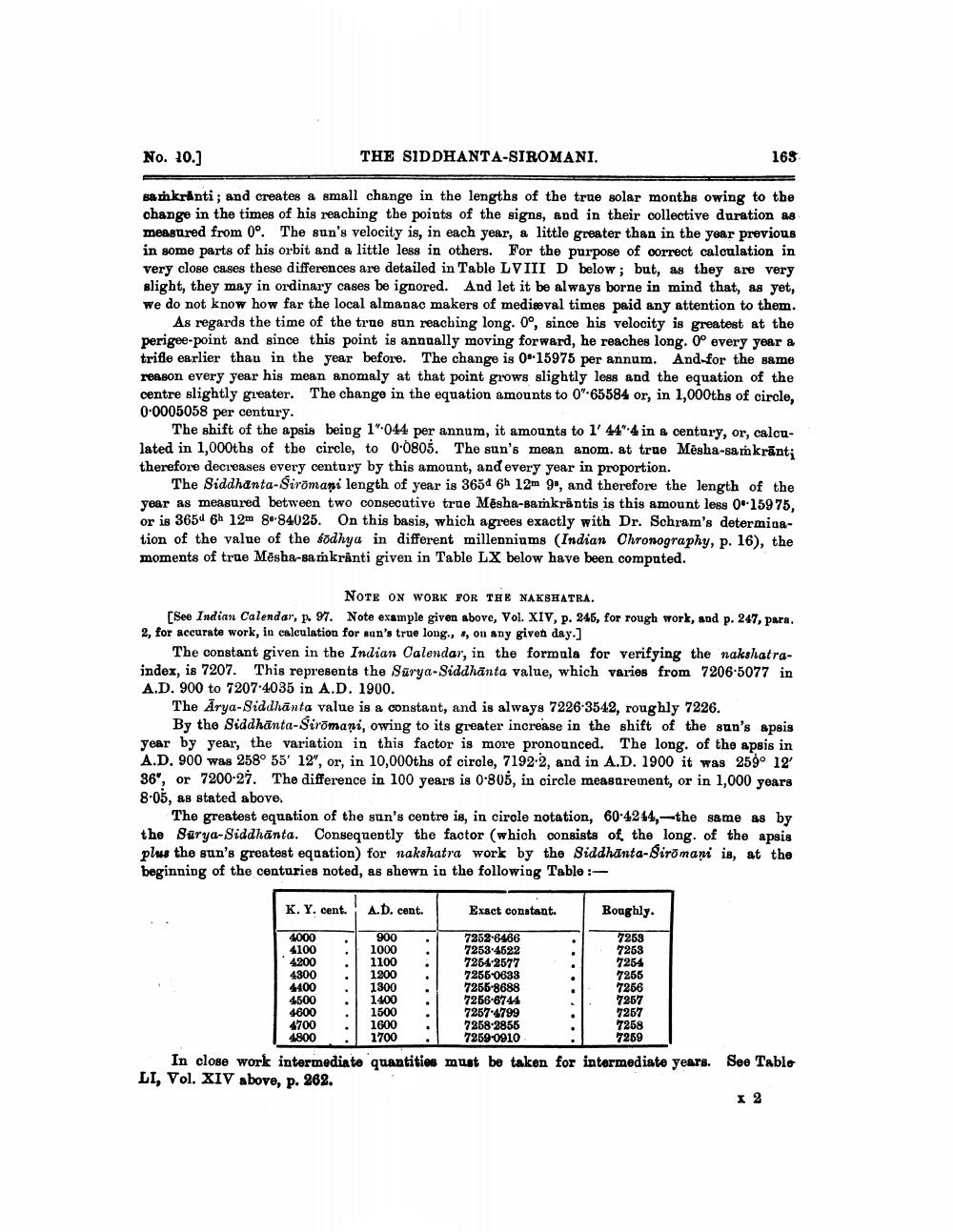________________
No. 10.]
samkrānti; and creates a small change in the lengths of the true solar months owing to the change in the times of his reaching the points of the signs, and in their collective duration as measured from 0°. The sun's velocity is, in each year, a little greater than in the year previous in some parts of his orbit and a little less in others. For the purpose of correct calculation in very close cases these differences are detailed in Table LVIII D below; but, as they are very slight, they may in ordinary cases be ignored. And let it be always borne in mind that, as yet, we do not know how far the local almanac makers of medieval times paid any attention to them.
As regards the time of the true sun reaching long. 0°, since his velocity is greatest at the perigee-point and since this point is annually moving forward, he reaches long. 0° every year a trifle earlier than in the year before. The change is 0-15975 per annum. And-for the same reason every year his mean anomaly at that point grows slightly less and the equation of the centre slightly greater. The change in the equation amounts to 0"-65584 or, in 1,000ths of circle, 0-0005058 per century.
The shift of the apsis being 1044 per annum, it amounts to 1' 44" 4 in a century, or, calculated in 1,000ths of the circle, to 0-0805. The sun's mean anom. at true Mesha-samkranti therefore decreases every century by this amount, and every year in proportion.
The Siddhanta-Siromani length of year is 365d 6h 12m 9, and therefore the length of the year as measured between two consecutive true Mesha-samkrāntis is this amount less 0-15975, or is 365 6h 12m 8-84025. On this basis, which agrees exactly with Dr. Schram's determination of the value of the sodhya in different millenniums (Indian Chronography, p. 16), the moments of true Mesha-samkrānti given in Table LX below have been computed.
THE SIDDHANTA-SIROMANI.
NOTE ON WORK FOR THE NAKSHATRA.
[See Indian Calendar, p. 97. Note example given above, Vol. XIV, p. 245, for rough work, and p. 247, para. 2, for accurate work, in calculation for sun's true long., s, on any given day.]
The constant given in the Indian Calendar, in the formula for verifying the nakshatraindex, is 7207. This represents the Surya-Siddhanta value, which varies from 7206-5077 in A.D. 900 to 7207-4035 in A.D. 1900.
The Arya-Siddhanta value is a constant, and is always 7226-3542, roughly 7226.
By the Siddhanta-Siromani, owing to its greater increase in the shift of the sun's apsis year by year, the variation in this factor is more pronounced. The long. of the apsis in A.D. 900 was 258° 55′ 12", or, in 10,000ths of circle, 7192-2, and in A.D. 1900 it was 259° 12' 36", or 7200-27. The difference in 100 years is 0.805, in circle measurement, or in 1,000 years 8.05, as stated above.
The greatest equation of the sun's centre is, in circle notation, 60-4244,-the same as by the Surya-Siddhanta. Consequently the factor (which consists of the long. of the apsis plus the sun's greatest equation) for nakshatra work by the Siddhanta-Siromani is, at the beginning of the centuries noted, as shewn in the following Table :
K. Y. cent. A.D. cent.
900
1000
1100
4000
4100
4200
4300
4400
4500
4600
4700
4800
1200
1300
1400
1500
1600
1700
Exact constant.
7252-6466
7253-4522
7254-2577
7255-0633
7255-8688
7256-6744
7257-4799
163
7258-2855 7259-0910
Roughly.
7253
7253
7254
7255
7256
7257
7257
7258
7259
In close work intermediate quantities must be taken for intermediate years. See Table LI, Vol. XIV above, p. 262.
x 2




